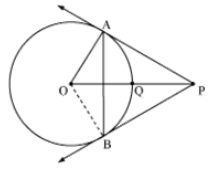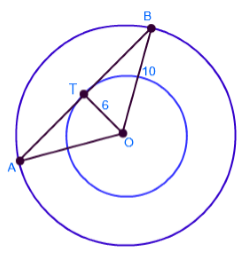CBSE Class 10 Maths Notes Chapter 10 Circles
Circle: A circle is a collection of all points in a plane which are at a constant distance from a fixed point.
Centre: The fixed point is called the centre.
Radius: The constant distance from the centre is called the radius.
Chord: A line segment joining any two points on a circle is called a chord.
Diameter: A chord passing through the centre of the circle is called diameter. It is the longest chord.
Tangent: When a line meets the circle at one point or two coincidings The line is known as points, a tangent.
The tangent to a circle is perpendicular to the radius through the point of contact.
⇒ OP ⊥ AB

The lengths of the two tangents from an external point to a circle are equal.
⇒ AP = PB

Length of Tangent Segment
PB and PA are normally called the lengths of tangents from outside point P.
Properties of Tangent to Circle
Theorem 1: Prove that the tangent at any point of a circle is perpendicular to the radius through the point of contact.
Given: XY is a tangent at point P to the circle with centre O.
To prove: OP ⊥ XY
Construction: Take a point Q on XY other than P and join OQ
Proof: If point Q lies inside the circle, then XY will become a secant and not a tangent to the circle
OQ > OP

This happens with every point on the line XY except the point P. OP is
the shortest of all the distances of the point O to the points of XY
OP ⊥ XY …[Shortest side is the perpendicular]
Theorem 2: A line drawn through the end point of a radius and perpendicular to it, is the tangent to the circle.
Given: A circle C(O, r) and a line APB is perpendicular to OP, where OP is the radius.
To prove: AB is tangent at P.
Construction: Take a point Q on the line AB, different from P and join OQ.
Proof: Since OP ⊥ AB
OP < OQ ⇒ OQ > OP

The point Q lies outside the circle.
Therefore, every point on AB, other than P, lies outside the circle.
This shows that AB meets the circle at point P.
Hence, AP is a tangent to the circle at P.
Theorem 3: Prove that the lengths of tangents drawn from an external point to a circle are equal
Given: PT and PS are tangents from an external point P to the circle with centre O.
To prove: PT = PS
Construction: Join O to P, T and S.

Proof: In ∆OTP and ∆OSP.
OT = OS …[radii of the same circle]
OP = OP …[common]
∠OTP = ∠OSP …[each 90°]
∆OTP = ∆OSP …[R.H.S.]
PT = PS …[CPCT.]
Note: If two tangents are drawn to a circle from an external point, then:
- They subtend equal angles at the centre i.e., ∠1 = ∠2.
- They are equally inclined to the segment joining the centre to that point i.e., ∠3 = ∠4.
∠OAP = ∠OAQ

Number of Tangents from a Point on a Circle
1. There could be only one tangent at one point of contact.
2. Tangent could not be drawn from any point inside the circle.
3. There could be only two tangents to a circle from any point outside the circle.
The lengths of tangents drawn from an external point to a circle are equal.

Here, two tangents are drawn from the external point C. As the
tangent is perpendicular to the radius, it formed the right angle
triangle.
So ∆AOC and ∆BOC are congruent right angle triangle. Hence AC = BC.
Example
If two tangents PA and PB are drawn to a circle from a point P with
centre O and OP is equal to the diameter of the circle then show that
triangle APB is an equilateral triangle.

SolutionGiven, AP is a tangent to the circle.
Therefore, OA ⊥ AP (Tangent is perpendicular to the radius through the point of contact)
∠OAP = 90°
In ∆OAP,

Likewise, we can prove that ∠OPB = 30°
Now, ∠APB = ∠OPA + ∠OPB = 30° + 30° = 60°
In ∆PAB, PA = PB (length of the tangents from the external point is equal)
∠PAB = ∠PBA (Angles opposite to equal sides are equal)
∠PAB + ∠PBA + ∠APB = 180° (Due to angle sum property)
∠PAB + ∠PBA = 180° - 60°
2∠PAB = 120
∠PAB = 60°
As ∠PAB = ∠PBA = ∠APB = 60°
Hence, PAB is an equilateral triangle.
Example
Find the length of AB in the given circle, which is the chord in the
outer circle and tangent to the inner circle. The radius of the inner
and outer circle is 6 cm and 10 cm respectively.

Solution :
Given :
Radius of the inner circle (r) = 6 cm
Radius of outer circle (R) = 10 cm
As the Point T which is the tangent point is the midpoint of the chord, AT = TB
As radius is perpendicular to the tangent,
So is a right angle triangle and we can use Pythagoras theorem.
OB2 = OT2 + TB2
TB2 = OB2 - OT2
= 102 - 62
= 100 – 36
TB2 = 64
TB = 8 cm
AB = TB + AT
AB = 8 + 8 (AT = BT)
AB = 16 cm
cbse class 10th circles












 AB is a line segment of 4 cm. Divide it in the ratio of 1:3 using a compass.
AB is a line segment of 4 cm. Divide it in the ratio of 1:3 using a compass.






















 In ΔACE
In ΔACE



 In a right angle triangle, the ratio of its side and the acute angles is the trigonometric ratios of the angles.
In a right angle triangle, the ratio of its side and the acute angles is the trigonometric ratios of the angles.







